Acute
Several villas in the northeast corner of the Botleys Park estate, belonging to the Botleys Park Colony for Mental Defectives, had been requisitioned and adapted for use as an acute hospital.
By December 1939 the Hospital had 218 beds. In addition, 15 huts in two rows, grouped along a central ramped corridor, were erected in the grounds by the Ministry of Defence; these were to provide an extra 500-600 beds. Four more huts contained an orthopaedic theatre, an X-ray Department, and Physiotherapy and Occupational Therapy Departments.
The central corridor, named 'The Ramp' due to its steep incline, was later covered to make an internal corridor, thus protecting patients and staff from the elements. More ward huts were added later.
Botleys Park mansion was used to accommodate medical and nursing staff from St Thomas' Hospital and St George's Hospital. Outlying buildings were also used for nurses' accommodation and stores. With the large increase in nursing and medical staff, there was an acute problem to house them all.
Civilian patients from St Thomas' Hospital and St James Hospital in Balham were transferred to the Hospital for treatment. Later, convoys of sick servicemen from France were received.
The Hospital received the first wounded soldier of the war, who had been injured by fragments of a bomb while on patrol in no-man's land. The first large convoy of military casualties arrived from those evacuated from the Battle of Dunkirk at the end of May 1940. Later, civilian victims of the London Blitz were also treated, but the Hospital mainly treated injured British and Allied Forces servicemen.
In May 1944 the patients were suddenly evacuated and the wards remained empty. A few weeks later casualties from the D-Day landings arrived.
The Hospital buildings received some bomb damage during the war, the last incident being on 17th May 1944.
After the war, the Hospital became a general hospital run by Surrey County Council.
In 1947 it was renamed St Peter's Hospital, after the mother church of St Peter's, Chertsey. A Training School for Nurses was established in Silverlands, just to the north of the Hospital, in order to replace the nurses from St Thomas' Hospital who returned to London in 1947.
In 1948 the Hospital joined the NHS as a general hospital under the control of the Woking and Chertsey Hospital Management Committee, part of the South West Metropolitan Regional Health Board. It had 403 beds. The operational running costs of the Hospital in the first nine months in the NHS were £314,079.
The EMS hutted wards were gradually upgraded, but it was not until 1961 that a plan was proposed to completely redevelop the site in five successive stages, to be completed by 1975. The new Hospital would have 1,100 beds, of which 708 would be acute, 129 maternity, 140 geriatric, 120 psychiatric and 26 mental handicapped. Further long-stay beds would be provided in the neighbouring Botleys Park Hospital.
In 1962 an Accident Centre was established (previously, staff had been summoned from the wards to attend to accident cases) and, in 1965, a Postgraduate Education Centre.
Phase 1 of the redevelopment scheme was completed in 1967, with the installation of five new operating theatres and associated recovery beds, and the establishment of a Central Sterile Supply Department. On 26th September 1967 the Duchess of Kent officially opened the new operating theatres.
Phase 2 was completed in 1970 when Abbey Wing, a maternity block opened. It had 120 beds and special care baby cots. The building also contained staff accommodation.
Phases 1 and 2 were completed on time at a total cost of £1.5m. But then the project stalled due to expenditure cuts.
Phase 3 was to have included a block to house a new Out-Patients Department with new X-ray, Physiotherapy, Occupational Therapy, Pathology and Pharmacy Departments. The Pathology Laboratory at that time occupied 600 sq. metres on two sites, but would have received 2,115 sq. metres of space. Similarly, the X-ray Department, in 300 sq. metres, would have been enlarged to some 1,250 sq. metres. The Pharmacy was housed in a former Polish Army hut, occupying some 170 sq. metres (as opposed to a projected 1,080 sq. metres in the new building). A new ward block, which would have provided 64 gynaecological beds, left the Hospital with only 24 such beds. The Accident Centre had only 3 beds but it was feared once the M3 motorway opened this would be grossly inadequate.
Phase 3 was to have also included a 120-bedded acute Psychiatric Department and a Day Unit, which would replace the facilities at the Holloway Sanatorium. In 1970 the only place the consultant psychiatrist could interview in-patients was in a linen cupboard, complete with linen.
Phase 4, planned to begin in 1977-78 would have provided a 480-bed surgical ward block and additional theatre suites. Phase 5, due to have begun in the early 1980s, included a medical ward block, of which 140 beds would be for geriatric patients, a new Postgraduate Education Centre, administrative buildings and other supporting facilities. More staff accommodation was also to be provided in Phases 3, 4 and 5.
In 1974, following a major reorganisation of the NHS, the Hospital came under the control of the North West Surrey District Health Authority, part of the South West Thames Regional Health Authority. It had 460 beds.
The modernization programme for the Hospital finally resumed in the early 1980s. In 1981 the McLeod Centre - the new Out-Patients Department - was opened by Geoffrey Pattie, the M.P. for Chertsey. The new block also contained day wards, an X-ray Department, a Physiotherapy Department and administrative offices. The main entrance to the Hospital was moved from The Ramp to its current position.
In 1988 the Abraham Cowley Unit for mental health opened. Patients were gradually transferred from Botleys Park Hospital, which closed in 1997. The majority of the surviving buildings of the Botleys Park estate were subsequently annexed by the Hospital, pending redevelopment.
Orthopaedic services were transferred into one of the old villas on the Hospital site in 1990, when the Rowley Bristow Orthopaedic Hospital in Pyrford closed.
In 1991 the Blanche Heriot Unit for genitourinary medicine opened in the Abbey Wing. It was named after a legendary local heroine, Blanche Heriot.
On 1st April 1992, following the introduction of the marketplace system of 'providers' and 'purchasers' in the NHS, the Hospital came under the control of the St Peter's Hospital NHS Trust.
In 1992 the Duchess of Kent returned to open a new Wing, named in her honour. The £11m building contained wards and also a new Postgraduate Education Centre, named after the physician Oliver Plunkett, who established the original Postgraduate Education Centre at the Hospital in 1966.
In April 1998 the Hospital merged with Ashford Hospital to form the Ashford & St Peter's NHS Trust. Services were reorganised between the two Hospitals, with Ashford Hospital undertaking elective surgical cases.
In the summer of 1998 the Prince Edward Wing was officially opened by Prince Edward himself. The new building contained an Accident & Emergency Department, the Rowley Bristow Centre for orthopaedics and an Intensive Care Unit. The Hospital then had 400 beds.
In January 2001, as a temporary measure, one of the old disused hutted wards was opened for elderly patients who had been medically discharged from the wards, but needed interim care and rehabilitation until they could be sent home or transferred to a nursing home. It was named the Hazel Centre and had 20 beds.
The Hazel Centre closed at the end of 2002 when additional beds and services became available in the community. The E.M.S. hutted wards of 'The Ramp' thereafter contained no patients and were then used as offices.
In 2005 the Neonatal Intensive Care Unit was upgraded at a cost of £1.5m. The new Unit was officially opened by Sophie, Countess of Wessex.
In 2006 the Duchess of Kent Wing was extended and two new wards added. The Medical High Dependency Unit opened on 1st February and the Surgical Assessment Unit in August.
In April 2008 the Acute Stroke and Brain Injury Unit opened.
In April 2009 the mortuary, a small rectangular building built in the 1940s for Botleys Park Hospital, closed when a new facility opened closer to the Hospital.
On 24th May 2010 the Stephanie Marks Diabetes Resource Centre was officially opened by Sir Ian Botham, O.B.E. It was named after a patient who had dreamed of becoming a doctor, but succumbed to the disease in 2002 at the age of 17 years.
Present status (September 2011)
The Hospital continues to be operational as a district general hospital. It has 400 beds and provides a wide range of acute care services.
Located in 52 acres (21 hectares), it comprises about 32 buildings of varied height - from one to four storeys - and of various architectural styles. The oldest are the single-storey E.M.S. ward huts (known as The Ramp buildings) built in 1939 in the centre of the site.
The Hospital is under the management
of the Ashford and St Peter's Hospitals NHS Foundation Trust, but the
site is shared by the Surrey and Borders Partnership NHS Foundation
Trust, who provide mental healthcare, and BMI The Runnymede Hospital, a
private hospital.
UPDATE: August 2017
In 2011 the E.M.S. huts at the lower end of The Ramp, including the Hazel Centre, were demolished and the site made into a staff car park.
Chertsey House, a new administrative and conference building, was completed in November 2011.
In March 2017 proposals were made to sell the land to the southwest of the Hospital (the former Botleys Park Hospital) for redevelopment. The Trust also wished to demolish the hutted wards of the upper part of The Ramp so as to create space for future developments.
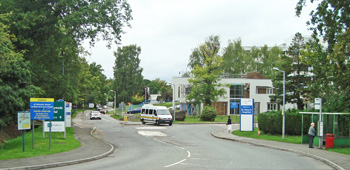
The main driveway to the Hospital off Guildford Road. The white building is the Stephanie Marks Resource Centre, which opened in 2010.
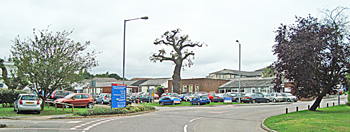
The site contains buildings of various architectural ages and styles (above and below).
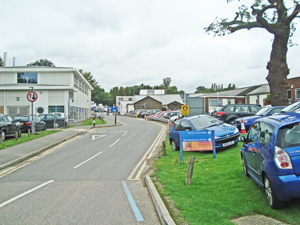
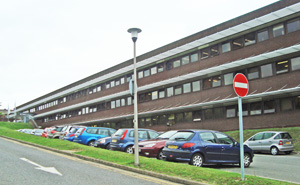
The McLeod Centre opened in 1981. It contains the Outpatients Department and support facilities.

The main entrance to the Hospital is in the McLeod Centre.
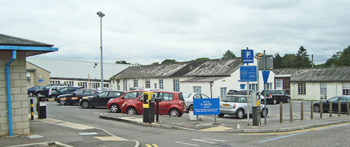
The E.M.S. hutted wards, built in 1939 for the Emergency Hospital, are gradually being demolished (above and below).
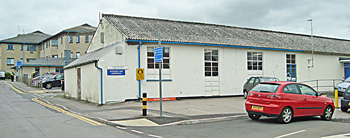

The oldest surviving part of the Hospital - a former villa of the Botleys Park Hospital, requisitoned in 1939 - became the Rowley Bristow Orthopaedic Centre in 1990. It is now the Supplies Department.
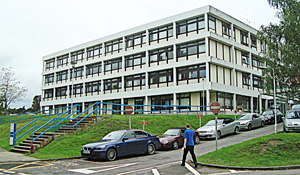
Abbey Wing, the maternity building, opened in 1970.

The Duchess of Kent Wing opened in 1992. The building contains the medical and surgical wards.
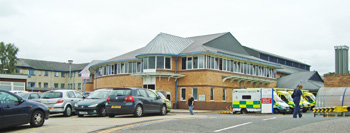
The Prince Edward Wing opened in 1998. It contains the Accident & Emergency Department and the Rowley Bristow Orthopaedic Unit.
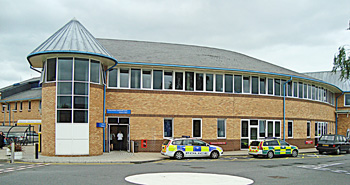
The entrance to the Accident & Emergency Department.

The sculpture Lightwaves by Duncan Bell, installed in February 2011, is located in the grounds of the Hospital.

The Abraham Cowley Unit opened in 1988. It provides in-patient and out-patients services for mental healthcare and is managed by the Surrey and Borders Partnership NHS Foundation Trust. The Trust also runs Windmill House, a specialist short-stay unit for people suffering from addition to drink or drugs.

Lake House, also run by the Surrey and Borders Partnership NHS Foundation Trust, provides care for adults aged from 18 to 65 suffering from mental health problems.
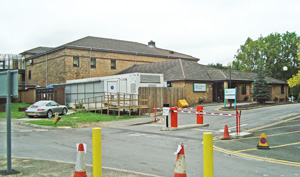
The Runnymede Hospital is part of BMI Healthcare and provides private surgical treatment.
http://chertseymuseum.org
http://hansard.millbanksystems.com
http://news.bbc.co.uk (1)
http://news.bbc.co.uk (2)
https://en.wikipedia.org
www.abandoned-derelict.co.uk
www.ashfordstpeters.info (1)
www.ashfordstpeters.info (2)
www.ashfordstpeters.info (3)
www.ashfordstpeters.info (4)
www.ashfordatpeters.info (5)
www.ashfordstpeters.nhs.uk (1)
www.ashfordstpeters.nhs.uk (2)
www.ashfordstpeters.nhs.uk (3)
www.ashfordstpeters.nhs.uk (-)
www.asph.mobi
www.alamy.com
www.delta-esourcing.com
www.derelictplaces.co.uk
www.geograph.org.uk
www.getsurrey.co.uk (1)
www.getsurrey.co.uk (2)
Return to home page